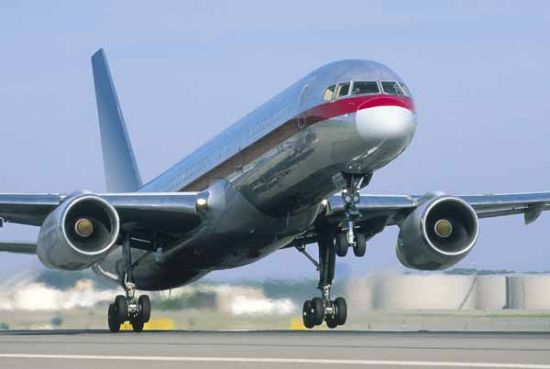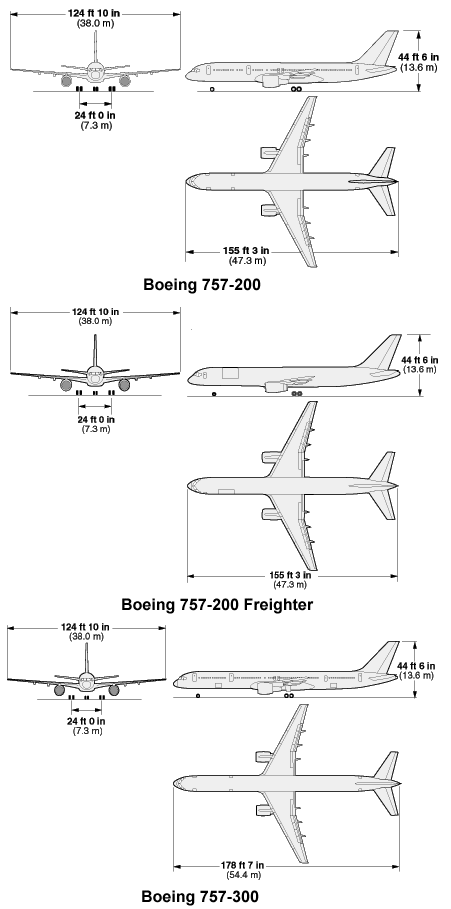|
||||||||||
|
|
||||||||||
|
||||||||||
|
|
||||||||||
 - -
|
|

|
Boeing 757 Short to Medium-Range Jetliner |
|
DESCRIPTION:
The Boeing 757 followed many years of design studies that explored replacing the 727, but the decision to proceed with a new aircraft finally came in early 1978. Envisioned as the first of a new family of advanced technology commercial airliners, the 757 retained the narrow fuselage cross-section of the 727 while the two following members of the family, the 767 and 777, feature wide-body fuselages. The 757 was designed for the short- to medium-range market for transcontinental routes where it competed with the rival Airbus A320 family. From the outset of the program, Boeing focused on economy of operation, especially high levels of fuel efficiency. The 757 incorporated a high-technology wing that significantly reduced drag, high bypass ratio turbofan engines, and computers that allowed the aircraft to operate at optimum efficiency throughout its flight. The 757 and 767 programs began within months of each other allowing the two projects to benefit from shared development costs. This emphasis on commonality also encouraged customers to purchase both designs for use on a variety of short-range, medium-range, and long-range routes. Both designs were powered by related families of engines from Pratt & Whitney, General Electric, or Rolls-Royce depending on customer preference. Although the 757 used a narrower, longer fuselage and a wing of reduced sweep and span compared to the 767, the two designs shared many common components. Among these were related tail assemblies, a common flight deck for the two or three crew, most avionics, flight management and air data computer systems, and major structural subassemblies. The 757 was built in several models including the 757-200, 757-300 stretched variant, and 757-200F cargo freighter. A total of 1,050 examples of the 757 were built, but Boeing closed the production line in October 2004 due to declining sales. Many customers have instead ordered newer stretched models of the Boeing 737 that can carry similar numbers of passengers over comparable ranges but cost less to purchase and operate.
Data below for 757-200 and 757-300 |
|
| HISTORY: | |
| First Flight |
(757-200) 19 February 1982 (757-200F) 13 August 1987 (757-200M) 15 July 1988 (757-300) 2 August 1998 |
|
Service Entry
|
(757-200) 1 January 1983 (with Eastern Airlines) (737-300) 19 March 1999 (with Condor) |
| CREW: |
two or three flight crew: pilot, co-pilot, flight engineer (early production models only)
|
| PASSENGERS: |
(757-200) 192 in two classes, 239 in one class (757-300) 239 in two classes, 289 in one class |
|
ESTIMATED COST:
|
unknown
|
| AIRFOIL SECTIONS: | |
| Wing Root | unknown |
|
Wing Tip
|
Boeing TR-51 mod
|
| DIMENSIONS: | |
| Length |
(757-200) 155.25 ft (47.32 m) (757-300) 178.58 ft (54.48 m) |
| Wingspan | 124.83 ft (38.05 m) |
| Height | 44.50 ft (13.56 m) |
| Wing Area | 1,951 ft² (181.25 m²) |
|
Canard Area
|
not applicable
|
| WEIGHTS: | |
| Empty |
(757-200) 126,060 lb (57,180 kg) (757-300) 141,300 lb (64,105 kg) |
| Normal Takeoff | unknown |
| Max Takeoff |
(757-200) 255,000 lb (115,665 kg) (757-300) 272,500 lb (123,605 kg) |
| Fuel Capacity |
(757-200) 11,275 gal (42,680 L) (757-200F) 12,115 gal (55,065 L) (757-300) 11,465 gal (43,400 L) |
|
Max Payload
|
(757-200) 72,210 lb (32,755 kg)
|
| PROPULSION: | |
| Powerplant |
(757-200) two Pratt & Whitney PW2037 or PW2040 turbofans or two Rolls-Royce RB211-535E4/4B turbofans (757-300) two Pratt & Whitney PW2043 turbofans or two Rolls-Royce RB211-535E4B turbofans |
| Thrust |
(PW2037) 73,200 lb (325.6 kN) (PW2040) 80,200 lb (356.8 kN) (PW2043) 85,200 lb (378.8 kN) (RB211-535E4) 80,400 lb (358.0 kN) (RB211-535E4B) 87,000 lb (387.0 kN) |
| PERFORMANCE: | |
| Max Level Speed |
at altitude: 580 mph (935 km/h) at 30,000 ft (9,140 m), Mach 0.86 at sea level: unknown cruise speed: 530 mph (850 km/h) at 35,000 ft (10,675 m), Mach 0.80 |
| Initial Climb Rate | unknown |
| Service Ceiling | 42,030 ft (12,810 m) |
| Range |
(757-200) 3,905 nm (7,240 km) (757-200F) 2,895 nm (5,370 km) (757-300) 3,450 nm (6,410 km) |
| g-Limits |
unknown
|
| KNOWN VARIANTS: | |
| 7N7 | Original designation for the 757 |
| 757-100 | Originally planned shortened model seating 150 passengers; cancelled |
| 757-200 | First production model; 995 total 757-200 airframes built |
| 757-200ERX | Extended-range variant of the 757-200 with two additional fuel tanks for increased capacity and stronger wing structure of the 757-300, offered 4,995 nm (9,250 km) range and maximum takeoff weight of 272,270 lb (123,500 kg) but no orders were received |
| 757-200F | Cargo freighter version based on the 757-200 |
| 757-200M Combi | Combination passenger/cargo model |
| 757-200 Special Freighter | Conversion package available for former passenger models modified into cargo freighters |
| 757-300 | Lengthened model able to carry up to 289 passengers and modified with strengthened wings and landing gear, new tires, and a tail skid; 55 built |
| 757BBJ3 |
Boeing Business Jet 3 derivative based on the 757-200; not built
|
| KNOWN OPERATORS: | |
| Civil |
Aeromexico Aero Peru Aerovias Air 2000 Air Belgium Air Europa Air Europe Air Greenland Air Holland Air Macau Air Niugini Air Scandic Air Scotland Air Senegal Airtours International Air Transat Alas Nacionales Allegiant Air American Airlines American Trans Air (ATA) America West Airlines Angle Airlines Ansett Worldwide Arkia Israeli Airlines Astraeus Atlas International AV8air Avianca Azerbaijan Airlines Babcock & Brown Aircraft Management Balair Blue Dart Aviation BMI British Midland Britannia Airways British Airways Caledonian Canada 3000 Cargojet China Southern Airlines China Southwest Airlines China Xinjiang Airlines Condor Flugdienst Conquest Vacations Continental Airlines Delta Air Lines Dinair Lineas Aereas Dutchbird Eastern Airlines El Al Israel Airlines Eos Ethiopian Airlines European Air Transport Far Eastern Air Transport FedEx Finnair Flyjet flyLAL Greece Airways Greenlandair Gulf Air Guyana Air 2000 Iberia Icelandair Iceland Express Iraqi Israir JMC Air Lapa Lauda Ledeco LTE International Airways LTU International Airways Martinair Mexicana Mid East Jet MyTravel Airways Monarch Airlines National Airlines Nepal Airlines Corporation North American Airlines Northwest Airlines OpenSkies Orient Eagle Airways Pace Airlines Privatair Royal Air Maroc Royal Aviation Royal Brunei Airlines Royal Nepal Airlines Royal Tongan Airlines Shanghai Airlines Siberia Airlines Song Airlines South Atlantic Airways TACV Thomas Cook Airlines Germany Thomas Cook Airlines UK Transaero Transavia Airlines Transbrasil Trans World Airlines (TWA) Turkmenistan Airlines United Airlines United Parcel Service (UPS) US Airways Uzbekistan Airways Venus Airways Vulcan Northwest Xiamen Airlines Xinjiang Airlines Zambia Airways Zoom Airlines |
| Government/Military |
Argentina, Fuerza Aérea Argentina (Argentine Air Force) Mexico, Fuerza Aérea Mexicana (Mexican Air Force) United States (US Air Force) United States (NASA) |
|
3-VIEW SCHEMATIC:

|
|
SOURCES:
|
|


|
Aircraft | Design | Ask Us | Shop | Search |

|
|
| About Us | Contact Us | Copyright © 1997-2023 | |||
|
|
|||